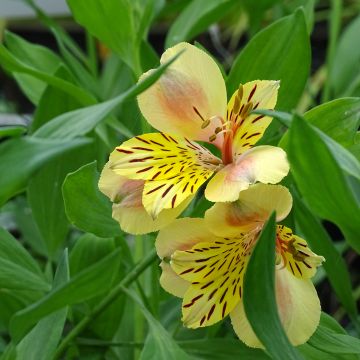

Gladiolus Ruby - Sword Lily
Gladiolus Ruby - Sword Lily
Gladiolus x papilio Ruby
Butterfly Gladiolus, Butterfly Sword Lily
Not all of them bloomed.
Boubou, 09/08/2025
Special offer!
Receive a €20 voucher for any order over €90 (excluding delivery costs, credit notes, and plastic-free options)!
1- Add your favorite plants to your cart.
2- Once you have reached €90, confirm your order (you can even choose the delivery date!).
3- As soon as your order is shipped, you will receive an email containing your voucher code, valid for 3 months (90 days).
Your voucher is unique and can only be used once, for any order with a minimum value of €20, excluding delivery costs.
Can be combined with other current offers, non-divisible and non-refundable.
Why not try an alternative variety in stock?
View all →This plant carries a 6 months recovery warranty
More information
We guarantee the quality of our plants for a full growing cycle, and will replace at our expense any plant that fails to recover under normal climatic and planting conditions.
Would this plant suit my garden?
Set up your Plantfit profile →
Description
This gladiolus or Gladiolus papilio 'Ruby', hardy in well-drained soil and adorned with charming ruby red flowers speckled with garnet, invites us to take another look at these plants. It is a rare and early form of the beautiful butterfly gladiolus, whose remarkably colourful flowers are also more tightly packed on the spike and slightly larger than those of the typical variety. It blooms from June-July until September-October in sunny borders and quickly multiplies to form stunning clumps, from which emerge elegant, thin yet sturdy stems, divinely flowered.
The genus Gladiolus belongs to the iris family, the cultivated varieties are hybrids divided into 3 major groups: Grandiflorus (large-flowered), Primulinus (early-flowering), and Nanus (butterflies). 'Ruby' belongs to the Nanus group, characterized by rather small and often speckled flowers, irregularly arranged on stems 60 to 70 cm (24 to 28in) tall, each bearing up to 20 florets. The upper petal of each flower has a curved helmet-like shape.
'Ruby' is a recent cultivar, derived among others from Gladiolus papilio, a species native to the marshy and mountainous areas of the Drakensberg in South Africa. It is a perennial and deciduous herbaceous plant with stoloniferous roots. Its foliage consists of thin, relatively short sword-shaped leaves, grey-green in colour, arranged in a fan shape and forming a 60 cm (24in) tall clump. The leaves are topped by a spike inflorescence with up to 7 buds, whose hooded flowers resemble those of certain orchids or even cannas, and are carried on very slender stems. Here they are a ruby red colour, with a purple throat, and turn a purplish shade before fading. The storage organ is a corm, which is a swollen stem with scales. Each corm will produce 2 or 3 flower spikes.
The Gladiolus papilio 'Ruby' has a great chance of changing the perspective of detractors of this plant, often considered stiff and lacking elegance to the point that it is relegated to the vegetable garden for cut flowers. Gladioli and their long colourful spikes are symbolic of the 70s and somewhat formal flower arrangements. While they are irreplaceable in bouquets, in gardens, their silhouette needs the company of plants with lush foliage that will showcase their blooming. Plant 'Ruby' in borders with grasses, forget-me-nots, and perennial flax, for example. Play with white for elegance and add here and there some silver foliage. Gladioli are regulars in cottage gardens, where they accompany vegetables all the way to the vegetable patch. For making bouquets, cut the flower spikes when the first floret starts to open.
The gladiolus gets its name from the shape of its sword-shaped leaves, derived from the Latin word gladius. Its wild forms were often represented in jewelry or on tapestries and fabrics made by the Semitic people before the Christian era.
Gladiolus Ruby - Sword Lily in pictures


Plant habit
Flowering
Foliage
Botanical data
Gladiolus
x papilio
Ruby
Iridaceae
Butterfly Gladiolus, Butterfly Sword Lily
Cultivar or hybrid
Other Gladioli
View all →Planting and care
The 'Ruby' Gladiolus loves rich, fertile but well-drained soils, so sandy soils are preferable and compact clay should be avoided. Plant it in full sun. Space the bulbs 10 to 15cm (4 to 6in) apart and cover them with 10cm (4in) of soil. Avoid using manure to fertilise the soil as it promotes bulb rot. This gladiolus can stay in the ground during winter, provided that the soil is not waterlogged and the plant is well mulched. Cut off the dry leaves. This variety multiplies through its stoloniferous roots, producing large clumps after a few years.
Planting period
Intended location
Care
Planting & care advice
-
, onOrder confirmed
Reply from on Promesse de fleurs
Similar products
Haven't found what you were looking for?
Hardiness is the lowest winter temperature a plant can endure without suffering serious damage or even dying. However, hardiness is affected by location (a sheltered area, such as a patio), protection (winter cover) and soil type (hardiness is improved by well-drained soil).

Photo Sharing Terms & Conditions
In order to encourage gardeners to interact and share their experiences, Promesse de fleurs offers various media enabling content to be uploaded onto its Site - in particular via the ‘Photo sharing’ module.
The User agrees to refrain from:
- Posting any content that is illegal, prejudicial, insulting, racist, inciteful to hatred, revisionist, contrary to public decency, that infringes on privacy or on the privacy rights of third parties, in particular the publicity rights of persons and goods, intellectual property rights, or the right to privacy.
- Submitting content on behalf of a third party;
- Impersonate the identity of a third party and/or publish any personal information about a third party;
In general, the User undertakes to refrain from any unethical behaviour.
All Content (in particular text, comments, files, images, photos, videos, creative works, etc.), which may be subject to property or intellectual property rights, image or other private rights, shall remain the property of the User, subject to the limited rights granted by the terms of the licence granted by Promesse de fleurs as stated below. Users are at liberty to publish or not to publish such Content on the Site, notably via the ‘Photo Sharing’ facility, and accept that this Content shall be made public and freely accessible, notably on the Internet.
Users further acknowledge, undertake to have ,and guarantee that they hold all necessary rights and permissions to publish such material on the Site, in particular with regard to the legislation in force pertaining to any privacy, property, intellectual property, image, or contractual rights, or rights of any other nature. By publishing such Content on the Site, Users acknowledge accepting full liability as publishers of the Content within the meaning of the law, and grant Promesse de fleurs, free of charge, an inclusive, worldwide licence for the said Content for the entire duration of its publication, including all reproduction, representation, up/downloading, displaying, performing, transmission, and storage rights.
Users also grant permission for their name to be linked to the Content and accept that this link may not always be made available.
By engaging in posting material, Users consent to their Content becoming automatically accessible on the Internet, in particular on other sites and/or blogs and/or web pages of the Promesse de fleurs site, including in particular social pages and the Promesse de fleurs catalogue.
Users may secure the removal of entrusted content free of charge by issuing a simple request via our contact form.
The flowering period indicated on our website applies to countries and regions located in USDA zone 8 (France, the United Kingdom, Ireland, the Netherlands, etc.)
It will vary according to where you live:
- In zones 9 to 10 (Italy, Spain, Greece, etc.), flowering will occur about 2 to 4 weeks earlier.
- In zones 6 to 7 (Germany, Poland, Slovenia, and lower mountainous regions), flowering will be delayed by 2 to 3 weeks.
- In zone 5 (Central Europe, Scandinavia), blooming will be delayed by 3 to 5 weeks.
In temperate climates, pruning of spring-flowering shrubs (forsythia, spireas, etc.) should be done just after flowering.
Pruning of summer-flowering shrubs (Indian Lilac, Perovskia, etc.) can be done in winter or spring.
In cold regions as well as with frost-sensitive plants, avoid pruning too early when severe frosts may still occur.
The planting period indicated on our website applies to countries and regions located in USDA zone 8 (France, United Kingdom, Ireland, Netherlands).
It will vary according to where you live:
- In Mediterranean zones (Marseille, Madrid, Milan, etc.), autumn and winter are the best planting periods.
- In continental zones (Strasbourg, Munich, Vienna, etc.), delay planting by 2 to 3 weeks in spring and bring it forward by 2 to 4 weeks in autumn.
- In mountainous regions (the Alps, Pyrenees, Carpathians, etc.), it is best to plant in late spring (May-June) or late summer (August-September).
The harvesting period indicated on our website applies to countries and regions in USDA zone 8 (France, England, Ireland, the Netherlands).
In colder areas (Scandinavia, Poland, Austria...) fruit and vegetable harvests are likely to be delayed by 3-4 weeks.
In warmer areas (Italy, Spain, Greece, etc.), harvesting will probably take place earlier, depending on weather conditions.
The sowing periods indicated on our website apply to countries and regions within USDA Zone 8 (France, UK, Ireland, Netherlands).
In colder areas (Scandinavia, Poland, Austria...), delay any outdoor sowing by 3-4 weeks, or sow under glass.
In warmer climes (Italy, Spain, Greece, etc.), bring outdoor sowing forward by a few weeks.




























































